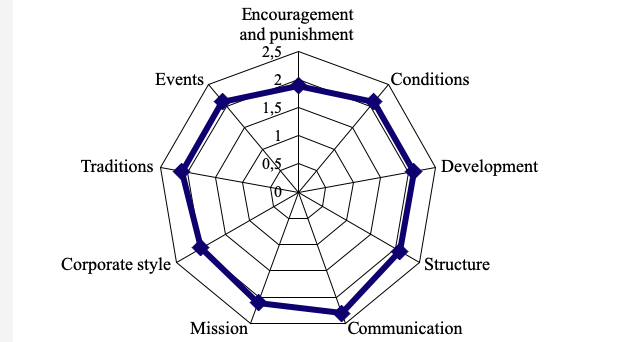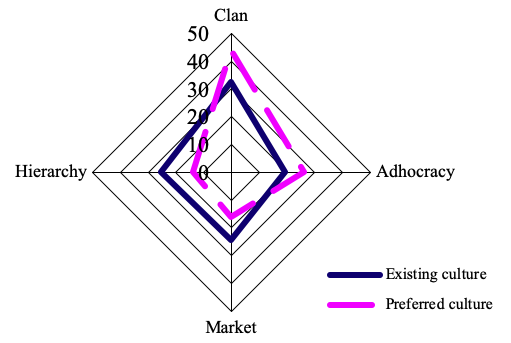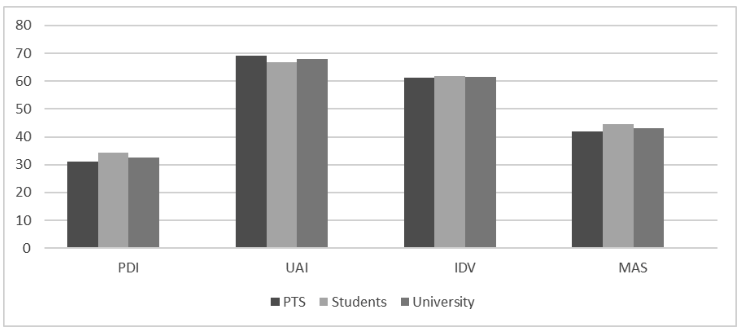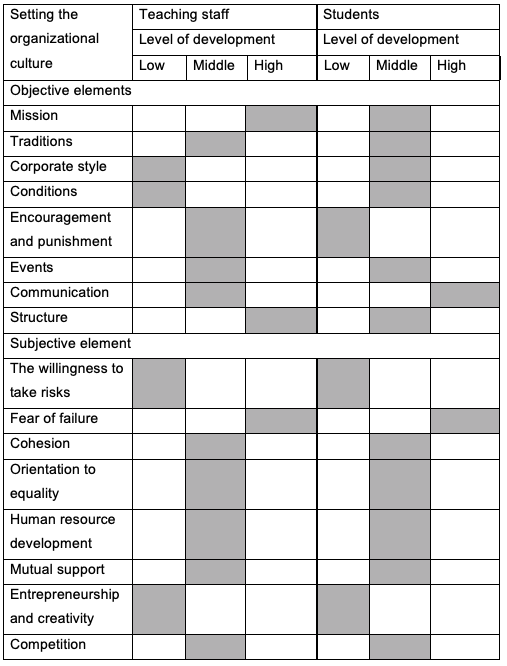

 Vol. 40 (Number 41) Year 2019. Page 17
Vol. 40 (Number 41) Year 2019. Page 17
GUS'KOVA, N.D. 1 & ERASTOVA, A.V. 2
Received: 02/09/2019 • Approved: 19/11/2019 • Published 25/11/2019
ABSTRACT: The purpose of the study is to assess the current level of development of the organizational culture of the university, determine its strengths and weaknesses and develop a program for its development. This will increase the manageability of both individual structural units, individual target groups, and the university as a whole. The study was based on methodological approaches to assessing the level of organizational culture developed by foreign scientists such as R. Holl, K. Cameron and P. Quinn, G. Hofstede, which allowed for getting the following results. The authors of the article adapted these approaches to study the culture of the university, developed a quantitative assessment according to the methodology by R. Hall, and tested the integration approach to assessing organizational culture. The studies allowed for getting a common vision of the key cultural and value guidelines of university employees and students and to identify the existing organizational culture in structural divisions and in higher educational establishments as a whole by its objective and subjective elements. An algorithm for assessing the organizational culture of a higher educational establishment based on an integration approach is proposed. The authors have developed specific activities aimed at developing a communication system, organizational values, psychological comfort and corporate image of the university, which will improve the quality of all management processes taking place at the university. |
RESUMEN: El propósito del estudio es evaluar el nivel actual de desarrollo de la cultura organizacional de la universidad, determinar sus fortalezas y debilidades y desarrollar un programa para su desarrollo. Esto aumentará la capacidad de administración de las unidades estructurales individuales, los grupos objetivo individuales y la universidad en su conjunto. El estudio se basó en enfoques metodológicos para evaluar el nivel de cultura organizacional desarrollado por científicos extranjeros como R. Holl, K. Cameron y P. Quinn, G. Hofstede, lo que permitió obtener los siguientes resultados. Los autores del artículo adaptaron estos enfoques para estudiar la cultura de la universidad, desarrollaron una evaluación cuantitativa de acuerdo con la metodología de R. Hall y probaron el enfoque de integración para evaluar la cultura organizacional. Los estudios permitieron obtener una visión común de las pautas culturales y de valor clave de los empleados y estudiantes universitarios e identificar la cultura organizacional existente en las divisiones estructurales y en los establecimientos de educación superior en su conjunto por sus elementos objetivos y subjetivos. Se propone un algoritmo para evaluar la cultura organizacional de un establecimiento de educación superior basado en un enfoque de integración. Los autores han desarrollado actividades específicas destinadas a desarrollar un sistema de comunicación, valores organizacionales, comodidad psicológica e imagen corporativa de la universidad, que mejorará la calidad de todos los procesos de gestión que tienen lugar en la universidad. |
Changes taking place in the modern world require high flexibility and adaptability of higher education institutions, which allows them to be competitive. One of the most important factors ensuring the university’s adaptability to the challenges of modern education is the level of development of organizational culture.
Organizational culture is the main component in fulfilling the mission of a higher educational establishment and achieving its main goals. Organizational culture can serve the benefit of the organization by creating an environment conducive to improving efficiency, creating a cohesive team and introducing innovative technologies. But it can work against the organization, creating barriers that impede the development and implementation of corporate strategies. These barriers are expressed in resistance to the new and lack of effective interaction between team members. In this case, changes in the organizational culture of the higher educational establishment are required.
Changes in organizational culture occur under the influence of factors of the external and internal environment. External factors include: globalization, Russia's accession to the WTO (World Trade Organization), digitalization of the economy, increasing competition, changing the scale of the university, changes in the labor market, etc. The factors of the internal environment affecting the organizational culture are changes in the quantity and quality of educational services provided by the university, the personality of the head, level of education and qualifications of the faculty, the level of infrastructure development, etc. The purpose of the study is to assess the current level of development of the organizational culture of the university, determine its strengths and weaknesses and develop a program for its development. This will increase the manageability of both individual structural units, individual target groups (students, teachers) and the university as a whole.
For the first time, a concept similar in meaning to organizational culture and called “corporate spirit” was introduced by the German military researcher C. von Clausewitz at the beginning of the 19th century. He believed that “...people who wholeheartedly surrender to some professional business identify themselves with the organization where they fulfill their needs. The behavior of these people is tinged with a tinge of devotion to organization” (von Clausewitz, 2009). The German field marshal H. von Moltke, being the founder of military thought, used the term "organizational culture", characterizing relations in the officer environment, which were regulated not only by charters, courts of honor but also by duels: saber scar was an important attribute of belonging to the officer "corporation" (von Clausewitz, 2009).
Western researchers identify the following reasons for turning to organizational culture as a management tool.
One of the first authors of the modern theory of organizational culture, in our opinion, should be considered the English scientist Jaques (1952), who represented the famous London Tavistock Institute of Human Relations. His main ideas in 1951 are presented in the book The Changing Culture of a Factory. The work reflects the first results of the introduction in companies of the principles and values of participatory management, cited by scientists of the Tavistock Institute. E. Jaques discloses the term “enterprise culture” as “a habitual, tradition-based way of thinking and a mode of action that all employees of this enterprise share to a greater or lesser extent and which must be assimilated and at least partially accepted by newcomers to these new team members became “their” people in it” (Jaques, 1952).
Interpretations of the essence of organizational culture, the authors conventionally divided into four groups. The first group consists of definitions that reflect the characteristics of the organization as a way of comprehending reality, the way of life and team interaction. The second group of definitions of the essence of organizational culture includes categories that describe the psychological and social aspects. The third group of definitions reflects the influence of organizational culture on the efficiency of an enterprise, expressed through various indicators. In the fourth group, organizational culture is considered as an integral category.
Having studied the approaches to this concept, it is proposed to understand organizational culture as an integral set of organizational values formed in the process of implementing the functional activities of the staff, their beliefs and norms of behavior, shared by key employees of the organization and influencing the implementation of its strategic and tactical goals.
Various approaches are used that are formed both in domestic and foreign literature to diagnose organizational culture and determine its level of development. Steklova classified all these approaches into ideographic and formalized approaches (2007).
Ideographic methods for assessing organizational culture involve descriptive studies that are based on an analysis of the collected primary data and information of a private nature without quantitative expression. Among the supporters of this approach, the most visible are Holl (2001), Deal, Kennedy (1982), Lunenburg (2011), etc.
Formalized assessment methods are based on various quantitative surveys in order to obtain statistical data about the object under study. Scientists sharing this approach include Hofstede (1980), Cameron and Quinn (1999), Kozlov (2013), Solomandina (2015), etc.
It should be noted that both ideographic and formalized methods have a number of advantages and disadvantages (Table 1).
Table 1
Comparative characteristics of research
methods of organizational culture
Ideographic methods |
Formal methods |
Advantages |
|
Availability of the studied database |
The availability of ready algorithms |
Identification of the relationship of the studied parties and problems |
Comparability of results |
Accuracy and visibility |
|
Objectivity of results |
|
The possibility of computerization |
|
Disadvantages |
|
Lack of instrumentality |
Individual subjectivity of expert review |
Required labor |
Large time consumptions |
In this regard, in order to obtain a more objective picture for the study of organizational culture, in the authors' opinion, it is more expedient to use several methodological approaches.
The organizational culture of the university is one of the separate areas of research that differ from the research of industrial organizations. This problem is considered in the writings by Gus'kova, Erastova (2018), Reznik, Chernikovskaya (2015), Tomilin (2018), etc.
Before carrying out the development and implementation of measures aimed at changing the organizational culture of the National Research Mordovian State University, one of the largest centers of higher education, science and culture of the Republic of Mordovia, it is necessary to analyze and assess the current state of its organizational culture. The number of respondents who participated in the study was 847, of which 100 were scientific and pedagogical workers and 747 were students.
To analyze and evaluate the organizational culture of the faculty and students of Ogarev MSU used the methodological approach by Holl (2001), adapted by the authors to study the organizational culture of the university. A quantitative rather than descriptive assessment of the objective elements of organizational culture has been proposed.
To study the surface level of the university’s organizational culture (A-parameter (artifacts and etiquette)), the authors studied the attitude of teachers and students towards key elements of the university’s corporate environment. Respondents were offered statements regarding the parameters characterizing the surface level of organizational culture on a three-point scale: 0 - no indicator, 3 - fully developed. A generalized estimate for each of the parameters is determined as the arithmetic mean value.
A study of the representations of the teaching staff regarding the elements of the surface level of organizational culture showed that the greatest development at Ogarev MSU received the mission and organizational structure. In the study environment, respondents noted their high knowledge and understanding. As elements that have received the least organizational development, the corporate style, working conditions, as well as the system of extracurricular development of the individual are identified (Figure 1).
Figure 1
Representation of the study of the surface
level of organizational culture of National
Research Mordovia State University through
the eyes of the faculty (in points)

At the same time, a study of the surface level of organizational culture in the opinion of students showed the dominance of the communication system, the least points were given to the reward and punishment system (Figure 2) (Deal and Kennedy, 1982).
Figure 2
Representation of the study of the surface
level of the organizational culture of
National Research Mordovia State University
through the eyes of students (in points)

The analysis of the subsurface level of organizational culture (B-parameter (behavior and actions)) was carried out using adapted for the university versions of questionnaires by Cameron and Quinn (1999). Assessment and determination of the existing and preferred (desired) dominant type of organizational culture were carried out in points. The total score for all types of organizational culture was 100 points. The dominant culture is its type, which received the most points according to the respondents.
The study showed that, according to the majority of respondents, both teachers and students, for Ogarev MSU is characterized by a clan type of organizational culture. Consequently, the emphasis is on improving the personality, cohesion, moral climate and traditions.
However, it should be noted that this type of culture is not strong enough, since along with it, the values of bureaucratic culture are widespread. So, according to representatives of geographical and law faculties, institutes of electronics and lighting engineering, mechanics and energy, historical, sociological and medical institutes, the organizational culture of the higher educational establishment is characterized by formalized, structured and long-term care in ensuring the stability of indicators.
Respondents of the Faculty of Mathematics and Information Technology, the Faculty of Economics and the Institute of National Culture believe that Ogarev MSU is more characteristic of the market type of culture. Therefore, it is advisable to talk about the presence of determination, competition and focus on results. The focus of the perspective is tuned to competitive actions, solving tasks and achieving measurable goals.
Adhocratic culture, with its dedication to innovation, creativity, personal initiative, and freedom, is defined as predominant in the higher educational establishment when studying opinions at the faculty of biotechnology and biology, as well as the agricultural institute.
A comparative analysis of the existing and desired profile of the organizational culture of the National Research Mordovian State University showed that there are cultural gaps in many faculties and institutes, with the exception of the faculty of pre-university training and secondary vocational education, the faculty of foreign languages, the agricultural institute and the institute of physics and chemistry.
There is a discrepancy in perceptions of the existing and desired types of the organizational culture of the higher educational establishment. Most of the respondents express an opinion on strengthening the cultural paradigms of the clan and adhocratic types while reducing the influence of market and hierarchical cultures. A comparison of the desired and existing types of culture as a whole for the higher educational establishment is presented in Figure 3.
Figure 3
Organizational profile of organizational culture of
National Research Mordovia State University (in points)

Basic value judgments (C-parameter (morality, beliefs, values)) were identified using the G. Hofstede methodology adapted for the university (Shahzad et al., 2012).
Based on respondents' answers to questions, four key indicators are identified that characterize organizational culture:
Indexes can be identified using an adapted version of the questionnaire, where statements are evaluated on a five-point scale. Full agreement with the statement is five points, and disagreement is 1 point. The arithmetic method calculates the average value and using the formula (1), one or another index is determined:
I = (а–3) × 25+50 (1)
where I is the index/indicator of organizational culture;
a - average score on a five-point scale.
This formula allows you to translate the assessment of each of the indices of culture in a 100-point scale. The level of development of the parameter can be estimated as low (0-35 points), medium (36-60) and high (61-100 points)
Assessment of the value judgments of respondents about organizational culture using this technique showed that in the opinion of the entire study group of structural units for Ogarev MSU is characterized by a low level of the Power Distance Index (PDI = 32.65) (Figure 4).
Figure 4
Results of the analysis of the C-parameter of the organizational
culture of National Research Mordovia State University (in points)

These values for the Power Distance parameter indicate the presence in the university of a collegial type of culture, characterized by a democratic management style. Uncertainty Avoidance Indicator (UAI = 67.95) is closer to high. In this regard, it is advisable to talk about the existence of great anxiety for the future, fear of failure, weak risk-taking. The smallest value of the “Desire to Avoid Uncertainty” index for the perception of the organizational culture of a university is recorded at the Faculty of Economics (UAI = 52.5), the highest - at the Faculty of Law (UAI = 87.5). An analysis of the Individualism Index (IDV showed that Ogarev MSU is characterized by cohesion and a strong influence on the emotional state of employees, since the collectivistic (workshop) type of organizational culture is predominant (IDV = 61.55). According to the results of the study, the prevalence as a characteristic of the organizational space of the university in the Masculinity parameter (MAS = 43.2) was not revealed. The smallest value of this parameter was noted by the Faculty of Economics (MAS = 15.0).
To summarize the data obtained, the authors compiled a map of the organizational and cultural values of the National Research Mordovian State University through the eyes of teachers and students (Table 1).
Table 1
Organizational and cultural perception of the employees
of National Research Mordovia State University

It should be noted that objective parameters (A-parameters) are quantitatively measurable, and subjective (B and C-parameters) were determined indirectly, based on the dominant type of culture and its indices. The results obtained will allow for improving the management of both structural units and the university as a whole, and to purposefully influence existing problem areas.
Thus, the study was based on the use of the author’s integrated methodology for assessing the level of development of organizational culture, its objective and subjective components. Using various methodological approaches, the authors of the study combined and adapted them for a comprehensive study of the organizational culture of the higher educational establishment.
The proposed methodology for assessing organizational culture contains five stages (Figure 5).
Figure 5
Algorithm for the diagnosis and development of
organizational culture using an integration method

The results of a study of the ideas of the faculty and students about organizational culture allowed for getting a common vision of the key cultural values and identify the existing organizational culture. However, the study showed the presence of fragmented perceptions of cultural elements by representatives of different divisions, sometimes having a diametrically opposite assessment of its parameters. In this regard, it is necessary to conduct a series of trainings for teachers and students aimed at developing a communication system, organizational values, psychological comfort, and a corporate image. At the same time, we consider it expedient to consider the development process of the identified components through the prism of the implementation of certain goals, which in turn will be criteria for assessing the effectiveness of the developed recommendations. A generalized vision of the possible tools of the program contributing to the development of the organizational culture of the higher educational establishment is presented in Table 2.
Table 2
Components and tools of the development of organizational
culture of National Research Mordovia State University
Elements of organizational culture |
Purpose |
Development tools |
Worldview |
The formation of a positive worldview, the determination of a person’s place in the team and the university environment as a whole. |
Trainings “Harmonious Development”, “Positive Thinking”. Conversations with psychologists. |
Organizational values |
Creation of conditions under which the personal goals of employees will contribute to the realization of the goals of the university. Raising a sense of pride in belonging to the university. |
A series of seminars "Strategy". Business game "Career". |
Psychological climate |
Development of tools for creating a favorable psychological climate in each structural unit of the university |
Trainings “Psychology of professional interpersonal communication”, “Professional authority and self-assertion of a specialist”, “Psychology of interpersonal conflict relations in a team”, and “Stress and personality of a specialist”. |
Management style |
Spreading of collegial leadership style. |
Coaching sessions with the heads of the higher educational establishment administration and the heads of structural units |
Communication system and communication language |
Building an effective communication system between teachers and students of different structural divisions of the higher educational establishment. |
Practical classes in rhetoric. Lectures "Culture of business communication".
|
Corporate image |
Identification of key elements of the image of both teachers, students, and the university environment as a whole. |
Training "Image of teacher and student". Organization of project activities. |
The introduction of a program related to the development of organizational culture into the system of internal learning will allow us to start the process of improving the social and spiritual field of the higher educational establishment and purposefully influence its problem areas.
Thus, in the course of the study, the need for an integrated assessment of organizational culture was substantiated. Based on the results of using diagnostic models by Holl, Cameron and Quinn, Hofstede the state matrix of the organizational culture of the Ogarev National Research Mordovian State University, which allowed us to identify key areas for improving and developing the organizational culture of this university. Recommendations have been developed on the development of organizational culture, providing for the formation of a common vision and cultural and value orientations of the higher educational establishment. The methodology for diagnosing the higher educational establishment’s organizational culture was tested, including not only the identification of the current state of the cultural and value space but also the possible directions for its improvement and development.
The use of the results as a basis for the implementation of measures to improve and further develop the organizational culture at the higher educational establishment, in the authors' opinion, seems to be a strategic prerogative that ensures the quality of all managerial processes taking place at the university.
Busse, R. (2014). Corporate culture, organizational change, and meaning at work: Linking human resources with business ethics. Human Systems Management, 33, 47-50.
Cameron, K., & Quinn, P. (1999). Diagnosing and Changing Organizational Culture. Boston: Addison-Wesley Publishing Company, Inc.
Deal, T., & Kennedy, A. (1982). Corporate Cultures: The Rites and Rituals of Corporate Life. Massachusetts: Addison-Wesley Publishing Co.
Fiordelissi, F., & Ricci, O. (2014). Corporate culture and CEO turnover. Journal of Corporate Finance, 28, 66-82.
Flamholtz, E., & Randle, Y. (2012). Corporate culture, business models, competitive advantage, strategic assets, and the bottom line. Journal of Human Resource Costing & Accounting, 16, 76-94.
Gus'kova, N., & Erastova, A. (2018). Evaluation of the student subculture of the university as a strategy to improve its competitiveness. Economic and Social Research, 4(20), 15-22.
Hofstede, G. (1980). Culture’s Consequences: International Differences in Work – Related Values. Beverly Hill: CA.
Holl, R. (2001). Organization: structure, processes, results. Saint Petersburg: Piter.
Jaques, E. (1952). The changing Culture of a Factory. New York: Dryden Press.
Jofreh, M., & Masoumi, E. (2013). Diagnosing organizational culture: An empirical investigation. Management Science Letters, 3, 2461-2466.
Kozlov, V., Odegov, Y., & Sidorova, V. (2013). Organizational culture: manual. Moscow: KNORUS.
Lebedeva, N., & Shironina, E. (2012). Methodological issues of the study of organizational culture. Basic research, 9, 729-733.
Lunenburg, S. (2011). Organizational culture-performance relationships: Views of excellence and theory Z. National Forum of Educational Administration and Supervision Journal, 29(4), 1-10.
Pathirange, Y. (2019). Organizational Culture and Business Performance: An Empirical Study. SSRG International Journal of Economics and Management Studies, 6(6), 1-12.
Reznik, S., & Chernikovskaya, M. (2015). The organizational culture of Russian students in the context of changes in the socio-economic environment: Monograph. Moscow: Scientific and Research Centre INFRA-M.
Sathe, V. (2985). Culture and Related Corporate Realities. Richard D. Irvin, Inc.
Shahzad, F., Luqman, R., Khan, A., & Shabbir, L. (2012). Impact of Organizational Culture on Organizational Performance: An Overview. Interdisciplinary Journal of Contemporary Research in Business January, 3(9), 975-985.
Shein, E. (2010). Organizational culture and leadership. San-Francisco: Jossey-Bass.
Solomandina, T. (2015). Organizational culture of the company: manual. Moscow: Scientific and Research Centre INFRA-M.
Steklova, O. (2007). Organizational structure: manual. Ulyanovsk: UlSTU.
Tomilin, O., Fadeeva, I., Tomilin, O., & Klyuev, A. (2018). Organizational culture of the Russian Universities: expectations and realities. Higher education in Russia, 1, 96-107.
Trice, H., & Beyer, S. (1993). The Cultures of Work Organizations. New Sersey: Prentice Hall.
Trompenaars, F., & Hampeden-Turner, C. (1997). Riding the Waves of Culture. Nickolas Brealey Publishing Limited.
von Clausewitz, C. (2009). On War. Moscow: Exmo.
1. Professor, Head of Management Department of National Research Mordovia State University (Federal State Budgetary Educational Institution of Higher Education “National Research Ogarev Mordovia State University”)
2. Associate Professor of Management Department of National Research Mordovia State University (Federal State Budgetary Educational Institution of Higher Education “National Research Ogarev Mordovia State University”). Contact e-mail: alexandra.erastova@mail.ru